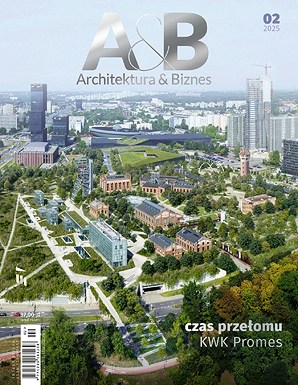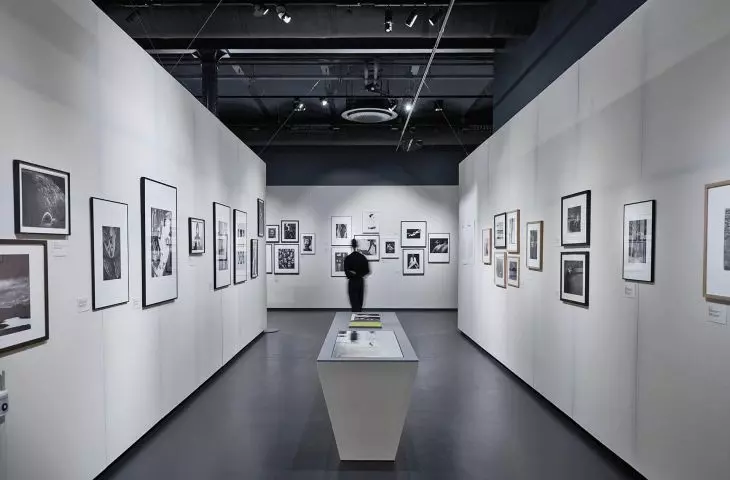The conversation comes from A&B 02|23
At the Museum of Photography in Krakow until May 7, 2023, we can discover the hitherto unknown world of Polish art photography, which will be discussed by Adam Mazur, curator of the exhibition.
Adam Mazur- Critic and theoretician of photography, art historian and Americanist. Since 2013 he has been teaching at the University of Arts in Poznan. Winner of the Rev. Szczęsny-Dettloff awards, the Jerzy Stajuda award and the Gloria Artis decoration. Editor of anthologies, catalogs and author of books. From 2002 to 2013, curator of the Warsaw CCA Ujazdowski Castle. Since 2013, he has been working as an independent curator. Together with Łukasz Gorczyca, he has been systematically compiling the history of Polish and Central European photography books since 2013. In 2019, he curated the exhibition "Fotoblok. Central Europe in Photobooks 1918-2018". The "Fotoblok" exhibition was also shown in the Czech Republic (2020) and Lithuania (2021). Editor-in-chief of "Obieg" magazine (2004-2011), co-founder and editor-in-chief of "SZUM" magazine (2013-2018). In 2018 he founded and edited the magazine "BLOK" until 2021.
Wiktor Bochenek:What is photography? Today it's a slightly dusty word.
Adam Mazur:"Fotografika"—a neologism created by Jan Bulgak—has become synonymous with photography for many people. It often continues to function that way, without distinction. This is the kind of shilling that Bulgak used to distinguish between ordinary photographers, about whom he spoke slightly disdainfully, calling them "snappers," and those who are aware of what the medium is. Photography should be considered a word that leads us away from ordinary photography toward artistic photography.
"Homeland photography"
Photo: Dorota Marta, MuFo
Victor: This word does not exist in any other language.
Adam:Yes, for many contemporary photographers who were cutting themselves off from artistic photography, this term was already a joke. Together with Lukasz Gorczyca, we wanted to restore the word to its original meaning and try to understand what generations of male and female photographers who wanted to practice art had in mind.
"Profession: photographer"
Photo: Dorota Marta, MuFo
Victor: When did photography end and photography begin?
Adam: The moment of transition from photography to photography is the most difficult to capture. This kind of transition has been discussed for decades. When Bulgak coined the term in the late 1920s, the community was organized into a network of exclusive photoclubs. Admission to this group was subject to a series of formal requirements with awards from salons, exhibitions and publication of one's achievements in the specialized press included. One had to work hard to earn the honorable title of photographer, and even so, a photographer was only a bystander. Even for Jan Bulhak, photography was a kind of subtle, artistic photography, which did not exclude professional activity, portrait or sightseeing photography, which he also advocated. Understood in this way, photography was a supreme achievement, something that photographers aspired to and were successful at.
view of the exhibition
photo: Dorota Marta, MuFo
Wiktor: At the exhibition, I encountered the notion of departure from reality in photography. What did it consist of?
Adam: Every sublimation has this in common, that it is a kind of departure from trivial things, like politics or social life. Photography was also criticized for this. It was rejected as a form of escapism and a way of aestheticizing reality. Even World War II was not an obstacle to the creation of autonomous works. The exhibition does feature the ruins of Warsaw, but framed in a very formalistic way. In "Fotografika" there is neither reporter photography nor strictly referring to what happened during those fifty years in politics or social life.
Excerpt from the section "Profession: photographer"
Photo: Dorota Marta, MuFo
Victor: What is it then?
Adam: There are works that show the sensitivity and emotions of artists, not social problems. If we think of art as an autonomous space, and this is how the photographers saw it, then the economic crisis or the problems of implementing land reform are completely irrelevant. Artistic photography is all about sensitivity, expression and mastering the technique as perfectly as possible.
Edward Hartwig, "Portrait of a female student," ca. 1955
© from the collection of MuFo
Wiktor: What is the reason for the time frame you proposed for the exhibition - 1927-1978?
Adam: In 1927 Bulgak used the word "photographer" for the first time in one of his texts. On the other hand, in 1978 Zofia Rydet began her "Sociological Record," which is a caesura in the history of Polish photography and is associated with the turn to reality, to the documentation of social and cultural changes. At this time, photographers, including Edward Hartwig, Zofia Rydet and Jerzy Lewczynski, abandon, as Rydet put it in the title of her album, "the world of imagination" and deal with everyday life and politics. They also associated this with the election of Karol Wojtyla as pope, the first activities of the democratic opposition, and Comrade Gierek's crisis of power.
Jan Bulhak, "Thistles in Zoliborz," 1945,
© private collection
Wiktor:How was the exhibition divided and what are the reasons for these divisions?
Adam:The exhibition is divided into seven chapters. We wanted it not to be boring. The first chapter is "Two Manifestos," which is a discussion between Jan Bulhak and Edward Hartwig on the title "photography." This is the first time the artists, considered the most important in Polish photography, have met each other. They have never before been exhibited directly side by side. Other chapters include "Photographic Subjects," "Domestic Photography" or "Profession: photographer." We have devoted several sequences of works, including those dealing specifically with the profession of photographer, to the dissolution of photography in the wider visual culture. We show the influence of and relationship between photography and the Polish poster school, including posters by Roman Cieślewicz and Wojciech Zamecznik. So in addition to vintage prints, we present a selection of catalogs, postcards and even educational boards that show how photographers slipped out of the ivory tower and kept in touch with reality. The exhibition concludes with a chapter titled "One." The title was taken from the exhibition so titled. It was a proto-feminist manifestation of female artists who presented photographs depicting the experience of femininity. Female photographers were in the minority in this male-dominated environment, but we wanted to show how important a role they played. In the exhibition, women are present in every chapter, with the exception of "Two Manifestos," and here we put additional emphasis on the work of such iconic figures as Natalia LL, Janina Gardzielewska and Fortunata Obrąpalska.
Jan Bulhak, "Warsaw. Muranów," 1949.
© from the MuFo collection
Wiktor:You presented the women's works in an interesting way - on navy blue fabric. Where did you get the idea for such an exposition of them?
Adam:The exhibition was designed by Damian Nowak and the BudCud studio. The curtain was invented by us, because how many walls can you put up? This dark blue curtain closes the exhibition, gives the whole thing a somewhat theatrical, but also less museum-like character. Behind this curtain is the end of the exhibition, in a symbolic sense the era of photography closes and contemporary photography, firmly rooted in reality, begins.
chapter "One"
Photo: Dorota Marta, MuFo
Wiktor: I would still like to ask about this juxtaposition of Edward Hartwig and Jan Bulgak, because it occurred in a rather narrow space as a contrast. What is the reason for such a representation?
Adam:"Two Manifestos" is a space more of a discussion than an argument. Jan Bulhak comes out with a certain idea and concept, he writes books, texts in which he expounds his concept of photography, but also of photographic education, attitude to technology, also to history and to Poland. A generation later, Edward Hartwig proposes his version of photography, much less metaphorical, more abstract and visually striking. Hartwig modernizes Bulgak's vision, giving photography a second life. The exhibition is a space for Hartwig's discussion with Bulgak, and is also an attempt to define the relationship between generations and backgrounds, which until now have largely been considered separately. Our concept was to include as many editors of photography as possible, approaches as different as those presented in the Vilnius and Lviv, Gliwice, Lodz and Poznan environments. These are simple gestures, but cognitively surprising and interesting not only to experts. Such a unique collection of the most beautiful photographs allows one to see the subtle differences, shifts, and sometimes attempts to break with photography altogether.
Zofia Rydet, "Transformations," from the series "World of Feelings and Imagination," ca. 1970.
© Zofia Rydet Foundation archive
Wiktor:How was the collaboration between the designers and curators?
Adam:We knew Damian Nowak before. We worked in 2015 on the exhibition "Vistula" realized for the Month of Photography in Krakow and in 2019 on the exhibition "Fotoblok", which I co-curated with Łukasz Gorczyca and Natalia Żak at the International Cultural Center in Krakow. These were very successful projects, so as soon as we got an invitation to organize an exhibition at MuFo, we didn't even think twice.
Fortunata Obrąpalska, "Dancer," ca. 1957
© from the collection of MuFo
Wiktor:What are the main things to look at in the exhibition?
Adam: The "Fotografika" exhibition is a collection of iconic works that have not been exhibited for years; the last time was at the National Museum in Wrocław twenty years ago. It was an exhibition showing the museum's collection curated by Adam Sobota. We wanted there to be works from various, including lesser-known museums, libraries and private collections. There are a lot of works that are fundamental for photography historians, and we can see them live once in a generation. The exhibition consists of vintage, period prints, made and signed by the authors and female authors. These are their most beautiful photographs, and this quality and materiality of photography is very much on display at MuFo. There is not a single print in the exhibition. In many museums today, unfortunately, we can see almost exclusively poor quality reprints instead of real photographic prints. It is a great pleasure to work with author's period prints and it is worth appreciating MuFo's effort to make such a collection public. During the creation of this exhibition, we wondered whether this would be visible to visitors. I think yes, that it is very visible and it's not just about photographs made in noble techniques. The experience of such old analog photography is what makes it worth going to the museum.
Wiktor:Thank you for the interview.
Jerzy Lewczynski, "Unknown" from the series "Wawel Heads," 1965
© from the collection of MuFo
interviewed by Wiktor Bochenek
Illustrations courtesy of the Museum of Photography in Krakow.





























































